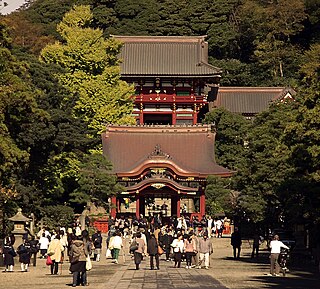
Kamakura officially Kamakura City is a city of Kanagawa Prefecture in Japan. It is located in the Kanto region on the island of Honshu. The city has an estimated population of 172,929 and a population density of 4,359 people per km2 over the total area of 39.67 km2 (15.32 sq mi). Kamakura was designated as a city on 3 November 1939.
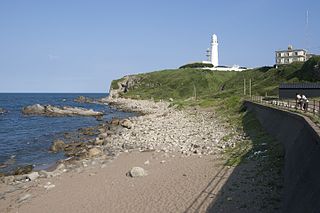
Chiba Prefecture is a prefecture of Japan located in the Kantō region of Honshu. Chiba Prefecture has a population of 6,278,060 and has a geographic area of 5,157 km2 (1,991 sq mi). Chiba Prefecture borders Ibaraki Prefecture to the north, Saitama Prefecture to the northwest, and Tokyo to the west.

The Chiba clan was a Japanese gōzoku and samurai family descending from the Taira clan. The clan was founded by Chiba Tsunetane, the son of Taira no Tadatsune. The Chiba governed in Shimōsa Province, and the clan was based in present-day Chiba City. Additionally, for a period, the clan controlled the Sōma Manor that extended into present-day Ibaraki. After the establishment of the Kamakura shogunate, the head of the Chiba clan became the hereditary shugo governor of Shimōsa Province.
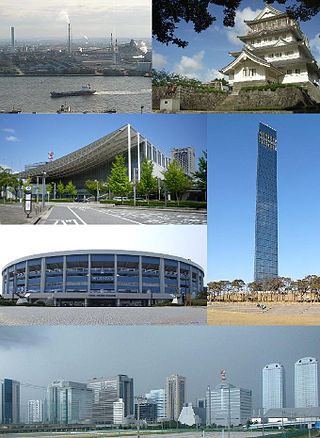
Chiba is the capital city of Chiba Prefecture, Japan. It sits about 40 kilometres (25 mi) east of the centre of Tokyo on Tokyo Bay. The city became a government-designated city in 1992. In June 2019, its population was 979,768, with a population density of 3,605 people per km2. The city has an area of 271.77 square kilometres (104.93 sq mi).

Banna-ji (鑁阿寺) is a Buddhist temple of the Shingon sect in the city of Ashikaga, Tochigi Prefecture, in northern Kantō region of Japan. The honzon of the temple is a statue of Dainichi Nyōrai, leading to the temple's nickname of Dainichisama,. The temple is built on the ruins of the ancestral fortified residence of the Ashikaga clan who ruled Japan during the Muromachi shogunate, and its grounds are a National Historic Site

Yoshida-Kōriyama Castle was a Japanese castle located in Akitakata, Hiroshima Prefecture. It was also called Aki-Kōriyama Castle from its location in former Aki Province. Its ruins have been protected by the central government as a National Historic Site since 1940.

Shichinohe Castle was a Japanese castle located in what is now the town of Shichinohe, in Kamikita District of Aomori Prefecture, in the Tōhoku region of far northern Japan. On December 13, 1941, the area was proclaimed a National Historic Site by the Japanese government.

Niitakayama Castle of Aki Province was a yamajiro-style Japanese castle located in what is today the Hongō neighborhood of the city of Mihara in Hiroshima Prefecture. Its ruins have been protected by the central government as a National Historic Site since 1957.

Okō Castle was a Japanese castle structure located in what is now part of the city of Nankoku Kōchi Prefecture, Japan. It was the original base of power for the Chōsokabe clan who were feudal lords of Tosa Province during the late Muromachi and Sengoku periods and famous as the birthplace of the warlord Chōsokabe Motochika. Its ruins have been protected as a National Historic Site since 2008.
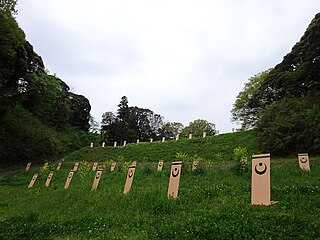
Moto Sakura Castle was a Muromachi period "hirayama"-style castle located on the border of the town of Shisui and the city of Sakura, Chiba Prefecture, Japan. Its ruins been protected as a National Historic Site since 1998.

Shingū Castle is a Japanese castle located in the city of Shingū, southern Wakayama Prefecture, Japan. At the end of the Edo period, Shingū Castle was home to a cadet branch of the Mizuno clan, hereditary karō of Kishū Domain. Its ruins, along with the clan cemetery for the Mizuno clan, were designated a National Historic Site in 2003. The castle is also called the Tankaku-jō (丹鶴城) or the Okimi-jō (沖見城).

Sadowara Castle is a Japanese castle located in the Sadowara neighborhood of the city of Miyazaki, Miyazaki Prefecture, on the island of Kyushu, Japan. It is also called Tsurumatsu Castle, and later Shōkaku Castle. During the Sengoku period, it was the stronghold of the Itō clan and later was controlled by the Shimazu clan. Shimazu Toyohisa was command of the castle. During the Edo period, the castle was headquarters of Sadowara Domain, which ruled portions of Hyūga Province from 1603 to 1871. The castle site has been a National Historic Site since 2004.

Kōkukuji Castle was a Sengoku period yamashiro-style Japanese castle located in the Negoya neighborhood of the city of Numazu, Shizuoka prefecture. The ruins have been protected as a National Historic Site since 1975.

Sugaya Yakata (菅谷館) was a Japanese castle located in what is now the town of Ranzan, Hiki District, Saitama, Japan. Its ruins have been protected as a National Historic Site, since 2008.
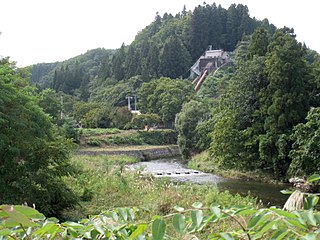
Tateyama Castle was a Sengoku period Japanese castle located in what is now the city of Yonezawa, southern Yamagata Prefecture, Japan. The site of the castle was designated a National Historic Site in 2016. The castle grounds are a 20 minutes walk from Nishi-Yonezawa Station on the JR East Yonesaka Line. It should not be confused with Tateyama Castle in Tateyama, Chiba, whose name is written with slightly different kanji.

Chiba Shrine is a Shinto shrine located in Chūō-ku, Chiba City, Chiba Prefecture. Originally a Buddhist temple dedicated to the deity Myōken, the patron of the Chiba clan, it was converted into a Shinto shrine dedicated to Ame-no-Minakanushi during the Meiji period.
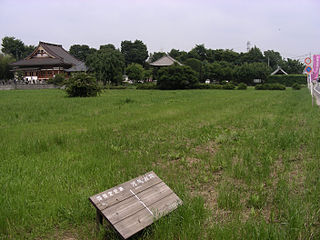
The Kawagoekan (河越館) was a hirayama-style Heian period Japanese castle located in the Uwado neighborhood of what is now the city of Kawagoe, Saitama Prefecture, in the Kantō region of Japan. The ruins been protected as a National Historic Site since 1984.

Nagano Castle was a Muromachi period "yamashiro"-style (castle located in the Misato neighborhood of the city of Tsu, Mie Prefecture, Japan. The ruins have been protected as a National Historic Site since 1982.
Shimizuyama Castle is a Kamakura to Sengoku period Japanese castle located in the former town of Shin'asahi, now part of Takashima city, in Shiga Prefecture, Japan. It was had curved rings arranged in three directions around the main enclosure, and the site of the vassals and other buildings at the foot of the mountain. Its ruins have been protected as a National Historic Site since 2004.
Soga Sukenobu was a Japanese samurai lord and gokenin of the late Heian and early Kamakura period. He was the lord of Soga Manor in Sagami Province. He was the adoptive father of Soga Tokimune and Sukenari, known for the Revenge of the Soga Brothers incident. He was also known as SogaTarō.






















